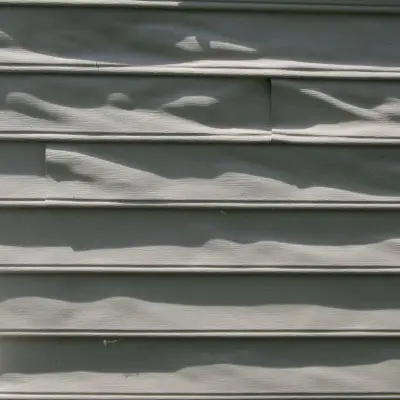Protect Your Home: A Comprehensive Guide to Dealing with Melted Siding
- usastormroofing
- No Comments

Extreme weather conditions can wreak havoc on your home’s exterior, and one of the most common issues homeowners face is melted siding. Whether it’s due to intense heat, wildfire exposure, or a neighbor’s unattended fire pit, melted siding can compromise your home’s insulation, energy efficiency, and curb appeal. In this comprehensive guide, we’ll explore the causes of melted siding, the potential risks it poses, and the steps you can take to address this issue effectively.
By understanding the importance of addressing melted siding promptly, you can safeguard your home’s structural integrity, prevent further damage, and maintain its aesthetic appeal. Let’s dive into the details and equip you with the knowledge to tackle this common problem head-on.
What Causes Siding to Melt?
Siding materials, particularly vinyl and some types of wood, are susceptible to melting or warping when exposed to extreme heat sources. The most common culprits include:
- Direct Sunlight: Prolonged exposure to intense sunlight can cause siding to become brittle and potentially melt, especially in hot climates or during heat waves.
- Wildfires: Homes in wildfire-prone areas are at risk of siding melting due to the intense radiant heat and potential direct exposure to flames.
- Nearby Fires: Unattended fire pits, grills, or even a neighbor’s house fire can subject your siding to enough heat to cause melting or warping.
It’s essential to understand these potential hazards and take preventive measures to protect your siding from excessive heat exposure whenever possible.
Risks of Ignoring Melted Siding
While melted siding may seem like a cosmetic issue at first glance, ignoring it can lead to more severe consequences for your home and its occupants. Some potential risks include:
- Energy Inefficiency: Melted or warped siding can create gaps and openings, compromising your home’s insulation and leading to higher energy bills.
- Water Damage: Gaps in the siding can allow water to seep in, potentially causing mold growth, rot, and structural damage over time.
- Fire Hazards: Melted siding can create pathways for flames to spread quickly in the event of a fire, putting your home and family at risk.
- Decreased Property Value: Neglected siding can significantly impact your home’s curb appeal and potentially lower its resale value.
Addressing melted siding promptly can help mitigate these risks and protect your investment in your home.
Assessing the Extent of Damage
Before taking any action, it’s crucial to assess the extent of the melted siding damage. Here’s what you should look for:
- Localized vs. Widespread: Determine whether the melting is isolated to a small area or if it’s more widespread across your home’s exterior.
- Depth of Damage: Evaluate how deep the melting has penetrated the siding material, as this will influence the repair or replacement approach.
- Structural Integrity: Check if the melting has compromised the structural integrity of the siding or any underlying components, such as insulation or sheathing.
Thoroughly assessing the damage will help you make an informed decision about the most appropriate course of action and provide accurate information to professional contractors when seeking their assistance.
Repair vs. Replacement Options
Depending on the extent of the damage, you may have the option to repair or replace the melted siding. Here’s a breakdown of the two approaches:
Repair
Repairing melted siding can be a cost-effective solution for localized damage or minor melting. This option typically involves:
- Removing the damaged section of siding
- Patching or splicing in a new piece to match the existing siding
- Ensuring proper sealing and insulation around the repaired area
Repairs can be a viable option for homeowners comfortable with basic DIY projects or those working with a professional contractor for minor issues.
Replacement
In cases of widespread or severe melted siding damage, a full replacement may be necessary. This approach involves:
- Removing all the existing siding from the affected area or the entire home
- Installing new siding materials, such as vinyl, fiber cement, or other heat-resistant options
- Addressing any underlying issues, like insulation or sheathing damage
While a full replacement can be more costly and time-consuming, it ensures a consistent and long-lasting solution, particularly for extensive damage or if your existing siding is outdated or incompatible with modern installation techniques.
Working with Professional Contractors
For more significant melted siding projects or if you’re uncomfortable tackling the repair or replacement yourself, it’s wise to enlist the help of professional siding contractors. Look for experienced and reputable contractors who:
- Are licensed and insured in your area
- Offer warranties on their workmanship and materials
- Have expertise in dealing with melted siding and heat-related damage
- Use high-quality, heat-resistant siding materials suitable for your climate
By working with professionals, you can ensure the job is done correctly, minimizing the risk of future issues and maximizing the longevity of your new or repaired siding.
Preventing Future Melted Siding Issues
Once you’ve addressed the current melted siding problem, it’s essential to take preventive measures to avoid future occurrences. Consider these strategies:
- Install Heat-Resistant Siding: Opt for siding materials designed to withstand high temperatures, such as fiber cement or engineered wood.
- Maintain Safe Distances: Keep potential heat sources, like fire pits or grills, a safe distance from your home’s exterior.
- Landscape for Protection: Strategic landscaping with heat-resistant plants or hardscaping can create a buffer zone around your home.
- Invest in Exterior Shading: Awnings, overhangs, or strategically planted trees can provide shade and reduce direct sunlight exposure.
By being proactive and taking preventive measures, you can minimize the risk of future melted siding issues and protect your home’s exterior for years to come.
Conclusion
Melted siding is a common problem that can have far-reaching consequences if left unaddressed. By understanding the causes, assessing the damage, and taking swift action through repair or replacement, you can safeguard your home’s structural integrity, energy efficiency, and curb appeal.
Remember, addressing melted siding promptly is crucial to preventing further damage and protecting your investment. Whether you choose to tackle the project yourself or enlist the help of professional contractors, prioritizing the health and safety of your home’s exterior should be a top priority.
With the right knowledge, tools, and preventive measures in place, you can confidently protect your home from the damaging effects of melted siding and enjoy a safe, energy-efficient, and visually appealing living space for years to come. Contact us today for expert tips and prevention methods.
